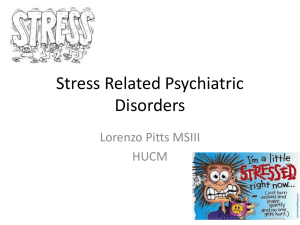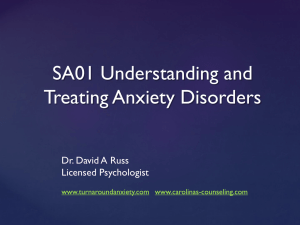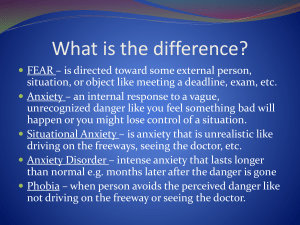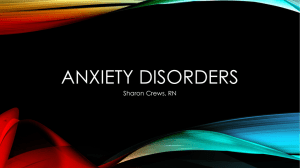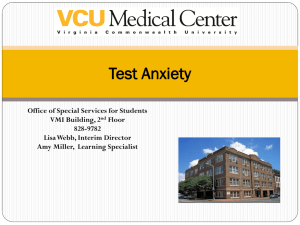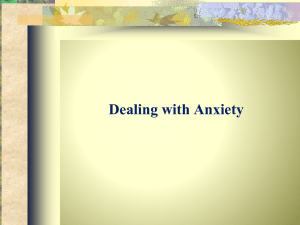a PowerPoint Presentation of Module 48
advertisement
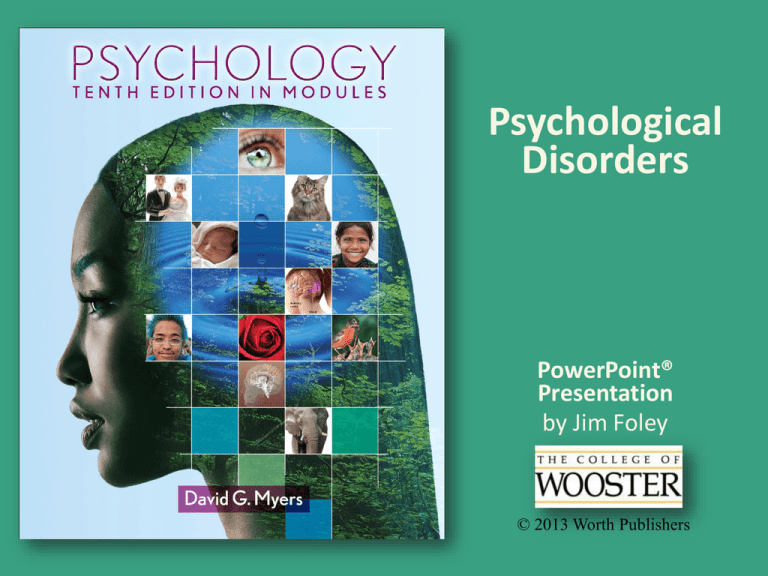
Psychological Disorders PowerPoint® Presentation by Jim Foley © 2013 Worth Publishers Module 48: Anxiety Disorders Anxiety Disorders GAD: Generalized anxiety disorder Panic disorder Phobias OCD: Obsessive-compulsive disorder PTSD: Post-traumatic stress disorder GAD: Generalized Anxiety Disorder Emotional-cognitive symptoms include worrying, having anxious feelings and thoughts about many subjects, and sometimes “free-floating” anxiety with no attachment to any subject. Anxious anticipation interferes with concentration. Physical symptoms include autonomic arousal, trembling, sweating, fidgeting, agitation, and sleep disruption. Panic Disorder: “I’m Dying” A panic attack is not just an “anxiety attack.” It may include: many minutes of intense dread or terror. chest pains, choking, numbness, or other frightening physical sensations. Patients may feel certain that it’s a heart attack. a feeling of a need to escape. Panic disorder refers to repeated and unexpected panic attacks, as well as a fear of the next attack, and a change in behavior to avoid panic attacks. Specific Phobia A specific phobia is more than just a strong fear or dislike. A specific phobia is diagnosed when there is an uncontrollable, irrational, intense desire to avoid the some object or situation. Even an image of the object can trigger a reaction--“GET IT AWAY FROM ME!!!”--the uncontrollable, irrational, intense desire to avoid the object of the phobia. Some Fears and Phobias What trends are evident here? Which varies more, fear or phobias? What does this imply? Some Other Phobias Agoraphobia is the avoidance of situations in which one will fear having a panic attack, especially a situation in which it is difficult to get help, and from which it difficult to escape. Social phobia refers to an intense fear of being watched and judged by others. It is visible as a fear of public appearances in which embarrassment or humiliation is possible, such as public speaking, eating, or performing. Obsessive-Compulsive Disorder [OCD] Obsessions are intense, unwanted worries, ideas, and images that repeatedly pop up in the mind. A compulsion is a repeatedly strong feeling of “needing” to carry out an action, even though it doesn’t feel like it makes sense. When is it a “disorder”? Distress: when you are deeply frustrated with not being able to control the behaviors or Dysfunction: when the time and mental energy spent on these thoughts and behaviors interfere with everyday life Common OCD Behaviors Percentage of children and adolescents with OCD reporting these obsessions or compulsions: Common pattern: RECHECKING Although you know that you’ve already made sure the door is locked, you feel you must check again. And again. Post-Traumatic Stress Disorder [PTSD] About 10 to 35 percent of people who experience trauma not only have burned-in memories, but also four weeks to a lifetime of: repeated intrusive recall of those memories. nightmares and other reexperiencing. social withdrawal or phobic avoidance. jumpy anxiety or hypervigilance. insomnia or sleep problems. Which People get PTSD? Those with less control in the situation Those traumatized more frequently Those with brain differences Those who have less resiliency Those who get re-traumatized Resilience and PostTraumatic Growth Resilience/recovery after trauma may include: some lingering, but not overwhelming, stress. finding strengths in yourself. finding connection with others. finding hope. seeing the trauma as a challenge that can be overcome. seeing yourself as a survivor. Years after he barely survived a terrorist attack that killed his wife and two children, Mr. Puskari suffers recurring flashbacks and frequent nightmares of the event that render him incapable of holding a steady job. Mr. Puskari is most clearly showing signs of: A. B. C. D. obsessive-compulsive disorder. generalized anxiety disorder. post-traumatic stress disorder. dysthymic disorder. From a learning perspective, phobias likely develop as a result of ___________, and ____________ helps to maintain them. A. B. C. D. operant conditioning; observational learning classical conditioning; reinforcement operant conditioning; reinforcement classical conditioning; observational learning Understanding Anxiety Disorders: Freudian/Psychodynamic Perspective Sigmund Freud felt that anxiety stems from repressed childhood impulses, socially inappropriate desires, and emotional conflicts. We repress/bury these issues in the unconscious mind, but they still come up, as anxiety. Classical Conditioning and Anxiety In the experiment by John B. Watson and Rosalie Rayner in 1920, Little Albert learned to feel fear around a rabbit because he had been conditioned to associate the bunny with a loud scary noise. Sometimes, such a conditioned response becomes overgeneralized. We may begin to fear all animals, everything fluffy, and any location where we had seen those, or even fear that those items could appear soon along with the noise. The result is a phobia or generalized anxiety. Operant Conditioning and Anxiety We may feel anxious in a situation and make a decision to leave. This makes us feel better and our anxious avoidance was just reinforced. If we know we have locked a door but feel anxious and compelled to re-check, rechecking will help us temporarily feel better. The result is an increase in anxious thoughts and behaviors. Observational Learning and Anxiety Experiments with humans and monkeys show that anxiety can be acquired through observational learning. If you see someone else avoiding or fearing some object or creature, you might pick up that fear and adopt it even after the original scared person is not around. In this way, fears get passed down in families. Cognition and Anxiety Cognition includes worried thoughts, as well as interpretations, appraisals, beliefs, predictions, and ruminations. Cognition includes mental habits such as hypervigilance (persistently watching out for danger). This accompanies anxiety in PTSD. In anxiety disorders, such cognitions appear repeatedly and make anxiety worse. Examples of Cognitions that can Worsen Anxiety: Cognitive errors, such as believing that we can predict that bad events will happen Irrational beliefs, such as “bad things don’t happen to good people, so if I was hurt, I must be bad” Mistaken appraisals, such as seeing aches as diseases, noises as dangers, and strangers as threats Misinterpretations of facial expressions and actions of others, such as thinking “they’re talking about me” Biology and Anxiety: An Evolutionary Perspective 1. Human phobic objects: 2. Similar but non-phobic objects: Snakes Fish Heights Low places Closed spaces Open spaces Darkness Bright light 3. Dangerous yet non-phobic subjects: We are likely to become cautious about, but not phobic about: Guns Electric wiring Cars Evolutionary psychologists believe that ancestors prone to fear the items on list #1 were less likely to die before reproducing. There has not been time for the innate fear of list #3 (the gun list) to spread in the population. Biology and Anxiety: Genes Studies show that identical twins, even raised separately, develop similar phobias (more similar than two unrelated people). Some people seem to have an inborn highstrung temperament, while others are more easygoing. Temperament may be encoded in our genes. Genes and Neurotransmitters Genes regulate levels of neurotransmitters. People with anxiety have problems with a gene associated with levels of serotonin, a neurotransmitter involved in regulating sleep and mood. People with anxiety also have a gene that triggers high levels of glutamate, an excitatory neurotransmitter involved in the brain’s alarm centers. Biology and Anxiety: The Brain Traumatic experiences can burn fear circuits into the amygdala; these circuits are later triggered and activated. Anxiety disorders include overarousal of brain areas involved in impulse control and habitual behaviors. The OCD brain shows extra activity in the ACC, which monitors our actions and checks for errors. ACC = anterior cingulate gyrus



